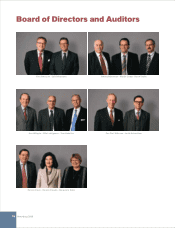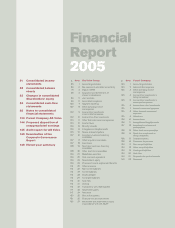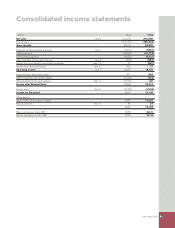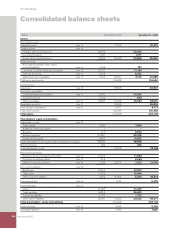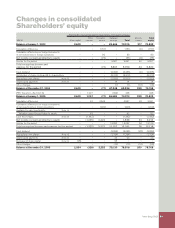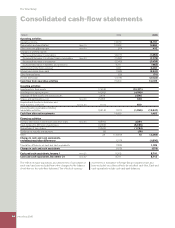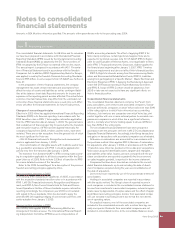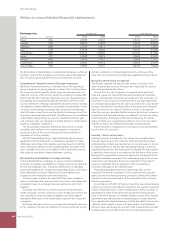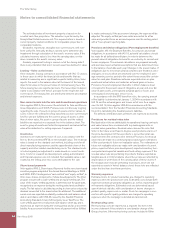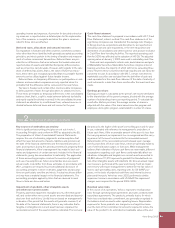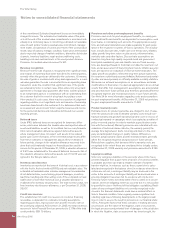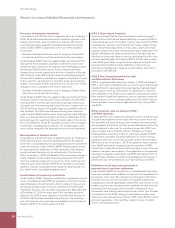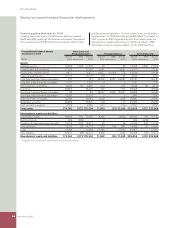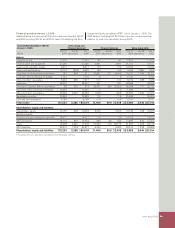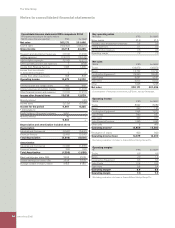Volvo 2005 Annual Report Download - page 92
Download and view the complete annual report
Please find page 92 of the 2005 Volvo annual report below. You can navigate through the pages in the report by either clicking on the pages listed below, or by using the keyword search tool below to find specific information within the annual report.
The Volvo Group
88 Volvo Group 2005
Notes to consolidated fi nancial statements
The estimated value of investment property is based on dis-
counted cash fl ow projections. The valuation is performed by the
Group’s Real Estate business unit. The required return is based on
current property market conditions for comparable properties in
comparable locations.
Goodwill is reported as intangible non-current assets with inde-
fi nite useful life. Annually, testing is carried out to determine any
impairment through calculation of the asset’s recovery value. If the
calculated recovery value is less than the carrying value, a write
down is made to the asset’s recovery value.
Similarly, impairment testing is carried out at the closing date if
there is any indication that a non-current asset has declined in value.
Leasing – Volvo as the lessee
Volvo evaluates leasing contracts in accordance with IAS 17, Leases.
In those cases in which the fi nancial risk and benefi ts that are
related to ownership are in signifi cant respects held by Volvo, Volvo
reports the asset in the balance sheet at the lowest of the leased
object’s fair value or the present value of minimal leasing fees. The
future leasing fees are reported as loans. The lease object is depre-
ciated in accordance with Volvo’s principle for the respective non-
current asset. The leasing fees are distributed between amortization
and interest expenses.
Non-current assets held for sale and discontinued operations
Volvo applies IFRS 5, Non-current Assets Held for Sale and Discon-
tinued Operations as of 2005. Processes are continuously ongoing
regarding the sale of assets or groups of assets at minor values. In
cases in which the criteria for being classifi ed as a non-current asset
held for sale are fulfi lled and the asset or group of assets is other
than of minor value, the asset or group of assets and the related
liabilities are reported on a separate line in the balance sheet. The
asset or group of assets are tested for impairment and valued at fair
value after deduction for selling expenses if impaired.
Inventories
Inventories are stated at the lower of cost, in accordance with the
fi rst-in, fi rst-out method (FIFO), or net realizable value. The historical
value is based on the standard cost method, including costs for all
direct manufacturing expenses and the apportionable share of the
capacity and other related manufacturing costs. The standard costs
is tested regularly an adjustment is made based on current condi-
tions. Costs for research and development, selling, administration
and fi nancial expenses are not included. Net realizable value is cal-
culated as the selling price less costs attributable to the sale.
Share-based payments
Volvo applies IFRS 2, Share-based Payments for the new share-based
incentive program adopted at the Annual General Meetings in 2004
and 2005. IFRS 2 distinguishes “cash-settled” and “equity-settled”, in
Volvo case, shares, components of share-based payments. The Volvo
program include both a cash-settled and an equity-settled part. The
value of the equity-settled payments is determined at the grant-date,
recognized as an expense during the vesting period and credited to
equity. The fair value is calculated according to share price reduced by
dividend connected to the share before the allotment. The additional
social costs are reported as a liability, revalued at each balance sheet
date in accordance with URA 46, issued by the Swedish Financial
Accounting Standards Council’s Emergency Issue Task Force. The
cash settled payment is revalued at each balance sheet day and is
reported as an expense during the vesting period and as a short term
liability. An assessment whether the terms of payment will be fulfi lled
is made continuously. If the assessment changes, the expense will be
adjusted. The equity-settled part was earlier accounted for at fair
value and provided for as an accrued expense over the vesting period
with a ”true-up”each reporting date.
Pensions and similar obligations (Postemployment benefi ts)
Volvo applies IAS 19, Employee Benefi ts, for pensions and similar
obligations. In accordance with IAS 19, actuarial calculations should
be made for all defi ned-benefi t plans in order to determine the
present value of obligations for benefi ts un-vested by its current and
former employees. The actuarial calculations are prepared annually
and are based upon actuarial assumptions that are determined close
to the balance sheet date each year. Changes in the present value of
obligations due to revised actuarial assumptions are treated as actu-
arial gains or losses which are amortized over the employees’ aver-
age remaining service period to the extent these exceed the corridor
value for each plan. Deviations between expected return on plan
assets and actual return are treated as actuarial gains or losses.
Provisions for post-employment benefi ts in Volvo’s balance sheet
correspond to the present value of obligations at year-end, less fair
value of plan assets, unrecognized actuarial gains or losses and
unrecognized unvested past service costs.
In accordance with the IFRS transition rules, the carrying amount
of the liability is determined at January 1, 2004 in accordance with
IAS 19 and the actuarial gains and losses set at zero. As a supple-
ment to IAS 19, Volvo applies URA 43 in accordance with the
recommendation from the Swedish Financial Accounting Standards
Council in calculating the Swedish pension liabilities.
For defi ned contribution plans premiums are expensed as incurred.
Provisions for residual value risks
Residual value risks are attributable to operational leasing contracts
and sales transactions combined with buy-back agreements or
residual value guarantees. Residual value risks are the risks that
Volvo in the future would have to dispose used products at a loss if
the price development of these products is worse than what was
expected when the contracts were entered. Provisions for residual
value risks are made on a continuing basis based upon estimations
of the used products’ future net realizable values. The estimations of
future net realizable values are made with consideration of current
prices, expected future price development, expected inventory turn-
over period and expected variable and fi xed selling expenses. If the
residual value risks are pertaining to products that are reported as
tangible assets in Volvo’s balance sheet, these risks are refl ected by
depreciation or write-down of the carrying value of these assets. If
the residual value risks are pertaining to products, which are not
reported as assets in Volvo’s balance sheet, these risks are refl ected
under the line item short-term provisions.
Warranty expenses
Estimated costs for product warranties are charged to operating
expenses when the products are sold. Estimated costs include both
expected contractual warranty obligations as well as expected good-
will warranty obligations. Estimated costs are determined based
upon historical statistics with consideration of known changes in
product quality, repair costs or similar. Costs for campaigns in con-
nection with specifi c quality problems are charged to operating
expenses when the campaign is decided and announced.
Restructuring costs
Restructuring costs are reported as a separate line item in the
income statement if they relate to a considerable change of the
Group structure. Other restructuring costs are included in Other


